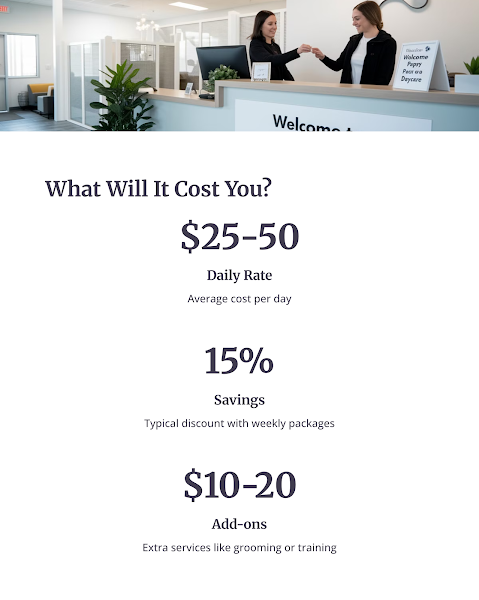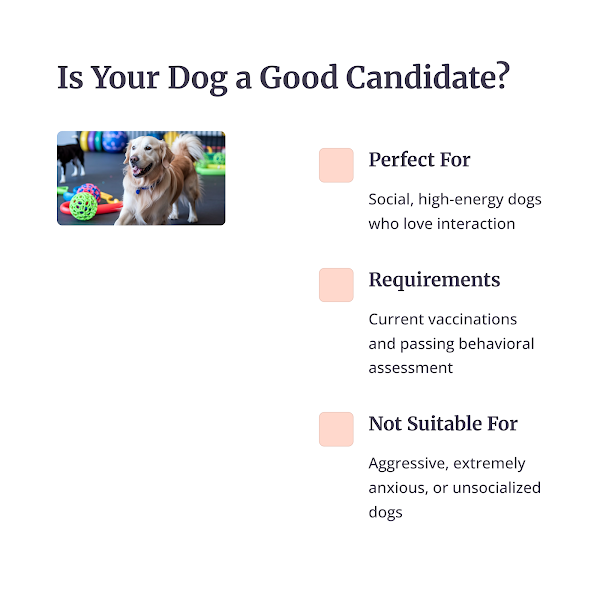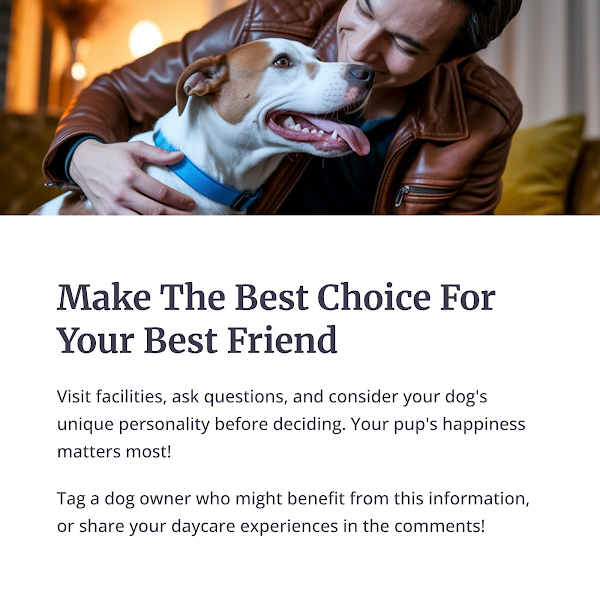Should You Send Your Dog to Daycare? Pros and Cons
🐾 What is Dog Daycare and How Does it Work?
As a loving dog owner, you want the best for your furry companion, especially when you're away from home. Dog daycare has become increasingly popular in recent years, offering a solution for busy pet parents.
Think of dog daycare as the canine equivalent of children's daycare. It's a supervised environment where your dog can spend time while you're at work or busy with other commitments.
Most facilities operate during regular business hours, typically from early morning until evening, allowing you to drop off your pet before work and pick them up afterward.
Unlike simple boarding, daycare focuses on socialization, play, and mental stimulation throughout the day. Your dog will interact with other dogs and receive attention from trained staff members.
| Daily Activities | Facility Features |
| Group playtime | Indoor play areas |
| Supervised socialization | Outdoor runs/yards |
| Rest periods | Separation by size/temperament |
| Optional training sessions | Webcam monitoring (some facilities) |
🦴 Benefits of Dog Daycare for Your Furry Friend
Sending your dog to daycare can provide numerous advantages for both you and your pet. Let's explore some of the most significant benefits that make dog daycare worth considering.
🐕 Regular socialization helps dogs develop better behavioral patterns and communication skills. Dogs are naturally social animals, and regular interaction with other dogs can help prevent or reduce anxiety and aggression.
🏃♂️ Physical exercise is crucial for your dog's health and happiness. At daycare, dogs typically engage in several hours of active play, helping to burn energy that might otherwise be directed toward destructive behaviors at home.
🧠 Mental stimulation is just as important as physical exercise. The new environments, interactions, and activities at daycare keep your dog's mind engaged and help prevent boredom.
😌 Reduced separation anxiety can be a significant benefit for dogs who struggle when left alone. The companionship and activities at daycare can help alleviate the stress of being separated from you.
⏰ Convenience for owners can't be overlooked. Knowing your dog is safe, supervised, and happy while you're at work provides peace of mind and eliminates the need to rush home for midday walks.
| Socialization | Exercise | Routine | Training |
| Play Skills | Energy Release | Structure | Reinforcement |
| Confidence | Physical Health | Consistency | Professional Care |
⚠️ Potential Drawbacks to Consider
While dog daycare offers many benefits, it's important to honestly evaluate potential downsides as well. Every dog is unique, and daycare isn't the right solution for every pet or owner.
💰 Cost considerations are often the first concern for many pet owners. Quality daycare services typically range from $25 to $50 per day, which can add up quickly if used multiple times per week.
😷 Health risks exist whenever dogs gather in groups. Even with vaccination requirements and cleanliness protocols, communicable illnesses like kennel cough can spread in daycare environments.
😨 Stress and overstimulation affect some dogs negatively. Not every dog thrives in the high-energy, social environment of daycare. Some may find it overwhelming rather than enjoyable.
🐕🦺 Personality mismatches can occur despite staff efforts to group compatible dogs. Some dogs may develop negative behaviors from interactions with dogs whose play styles don't match theirs.
⏱️ Scheduling constraints are another practical consideration. Most daycares have specific drop-off and pick-up times, which may not align perfectly with your schedule.
🔍 Signs Dog Daycare is Right for Your Pet
How do you know if your dog would benefit from daycare? Look for these indicators that suggest your furry friend might enjoy and thrive in a daycare environment.
🤗 Social behavior is perhaps the most important factor. Dogs who actively seek interaction with other dogs at parks or on walks are often good candidates for daycare.
⚡ High energy levels that aren't sufficiently channeled at home may indicate a need for the additional activity daycare provides. If your dog seems bored or destructive when left alone, daycare could help.
🏠 Home alone issues such as excessive barking, destructive chewing, or signs of anxiety might be mitigated by daycare attendance. Many behavior problems stem from boredom or loneliness.
Before committing to a regular schedule, consider doing a trial day at your chosen facility. Most reputable daycares offer temperament testing and will honestly tell you if your dog seems comfortable in their environment.
🏠 Alternatives to Traditional Dog Daycare
If you've evaluated dog daycare and decided it's not the right fit for your pet or your circumstances, don't worry! Several alternatives can provide care and companionship for your dog while you're away.
🚶♀️ Professional dog walkers can visit your home once or twice during the day to provide exercise and bathroom breaks. This option offers one-on-one attention and keeps your dog in their familiar environment.
🏡 In-home pet sitters provide more extensive care, sometimes staying in your home while you're away. This can be less stressful for dogs who don't enjoy new environments or other dogs.
👨👩👧👦 Family or friend assistance might be available if you have trusted people nearby who are willing to help. This familiar-person approach can be particularly good for shy or anxious dogs.
🤖 Technology solutions can help bridge the gap when human companionship isn't available. Interactive toys, treat dispensers, and video call devices designed for pets can provide some stimulation.
🐾 Final Thoughts: Is Dog Daycare Right for Your Pet?
Making the decision about dog daycare requires balancing your pet's needs, your schedule, and your budget. There's no one-size-fits-all answer, as each dog has a unique personality and set of needs.
Remember that your dog's happiness and well-being should be the primary consideration. Take time to observe how your dog responds after trial days at daycare – do they seem tired but content, or stressed and depleted?
Many owners find that a mixed approach works best – perhaps daycare two or three days a week, combined with other care solutions on alternate days. This provides socialization benefits while preventing potential overstimulation.
Whatever you decide, invest time in finding a quality facility with well-trained staff, appropriate safety measures, and transparency in their operations. The right environment can make all the difference in your dog's daycare experience.
| How often should dogs attend daycare? | Most experts recommend 2-3 days per week for the average dog. This provides socialization benefits without overstimulation. Your dog's age, energy level, and personality should inform your specific schedule. |
|---|---|
| What should I look for in a quality daycare facility? | Look for proper licensing, staff trained in dog behavior, clean facilities, appropriate dog-to-staff ratios, separate areas for different sized dogs, and transparent policies about handling emergencies or behavioral issues. |
| How will I know if my dog is enjoying daycare? | Happy daycare attendees typically show excitement when arriving at the facility, come home tired but content (not stressed), and maintain good behavioral patterns. Many facilities also provide reports or photos of your dog's activities. |










Comments
Post a Comment